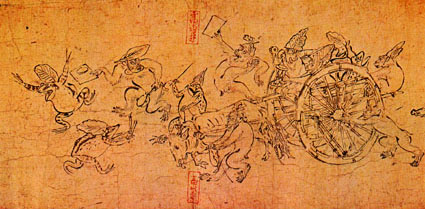
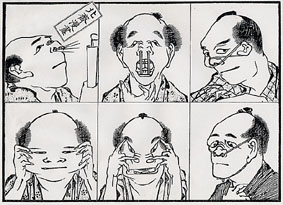
Influence of Pop-culture in Children's Art:
Possibilities of implementing manga in art educational
curricula
Masami Toku
California State University, Chico
May, 2000
Introduction
Why donít some people like art, in spite of the fact that they used to love art when they were children? Why do many people stop making art when they reach certain ages? One of the major problems facing art education is the loss of children's interest in art as they get older. Is there no hope for teachers to support artist development through this difficult period? In this article, I would like to discuss the mechanism of the loss of children's interest in art based on children's artistic developmental theories. I would also like to discuss the possibility of recapturing children's interest by implementing pop-culture into art educational curricula based on the recent study of the influence of visual culture in children's art.
Internal and external disruptions in children's artistic development
When, how, and why do children tend to lose their interest in making art and interest in art itself? There are two different types of disruptions, which do not allow childrenís artistic ability to develop in a linear progression with age, which we may call 1) internal disruptions of self-awareness and 2) external disruptions of environment, especially during adolescence.
Piagetians, including Lowenfeld and Brittain (1970) explain childrenís artistic development as a hierarchical linear progression called the stage theory of cognitive development. However, post-Piagetians point out the weakness of the stage theory in terms of the lack of the explanation for the transition period from child to adolescent art, which we may call the period of losing interest in art. It starts from middle childhood, around 14 years old. Thus, childrenís artistic development does not always show a linear progression since their own internal disruptions cause them to lose their interest or motivation to create art. Some researchers indicate that it is an unavoidable period of the process of making self (ego). For example, an English art educator, Read (1958) explains that most childrenís artistic ability declines around 11 to 14 years old. He called it the period of oppression. American psychologists, Gardner and et al (1993) also explain the tendency of decline during middle childhood in the pattern of a U-curve of cognitive development. The most understandable reason for the phenomenon is that children themselves start to realize the limitations of their artistic skills for producing realistic art. In spite of the fact that children can see whatís going on in the real world, they cannot draw what they see. They struggle when they know the limitations of their skills. As a result, most children start to reject making art at that point. Only a few people who are identified as gifted will go beyond this period and keep making art or making self through their art activities. In other words, childrenís artistic development is ironically disturbed by their self-awakening, which is an internal disturbance.
Concerning external disruptions which surround children in their environment, there are at least three possible cases of how and why they start to lose their interest in art: 1) the lack of teacherís encouragement for studentsí artwork (misunderstanding the value of studentsí artworks), 2) the lack of studentsí understanding of the value of art in life, and 3) the lack of teachersí understanding studentsí real interests for art.
For instance, when I asked my friends who do not like
art very much why they do not like art, some of them said that they disliked
art teachers rather than art itself. They seemed to lose their interest
in art because of art teachersí insensitive words or attitudes toward their
artworks. Why do teachersí attitudes often inhibit childrenís motivation
to create art? One of my friends explained that the reason she lost her
interest in art was that her teacher did not appreciate her expressive
artwork due to her lack of skill. Likewise art teachers often unconsciously
judge the value of studentsí artworks based on the teacherís preference
reflecting the value of traditional art. Secondly, many people not only
students but even adults like parents and classroom teachers, believe that
art is not important compared to other academic subjects, since art is
not important to their everyday lives. Some people might say that they
could live without art. Why do they think that art is not important in
their life? In reality, art educational curricula were not successful enough
to support the development of childrenís making mind in spite of the fact
that art should be a strong communicative tool to develop our critical
thinking skills. Finally, teachers donít often realize how the art curriculum
is developed while ignoring studentsí real interests or preferences for
art. As a result, teachers tend to teach art based on the value of "high
art" (that which is admitted as art by art society), not by children themselves.
One day, one of my 8th grade students asked me to teach a more fun project
rather than traditional art projects such as drawing a self-portrait with
emotional expression with the concept of elements of art including line,
shape, color, texture, and so on. Simply, he asked me if he could draw
a cartoon like Pokemon. Of course, I gently rejected his request. "No,
you canít draw such a cartoon character since you cannot learn the concepts
of art from cartoons or comic books."
There is a Japanese saying that there are many talented
racehorses, but only a few good trainers who can find and encourage their
talent to become a racehorse. I also feel that there are many talented
children (even though they do not realize it), but only a few good art
teachers who know why, what, and how to teach. I may not be an exception
since I could not go beyond my old traditional concept of what is art and
what I should teach through art education in those days.
Thus, if children start to lose their interest is due
to the above internal and external disruptions, do we still have hope to
encourage childrenís artistic development? Can we draw their interest towards
creating art even during such an oppressive period? Can we support the
development of their making mind through art education? It is time to reevaluate
the value of art for especially secondary grades, which face the crisis
of losing interest in art. What should we teach and how should we teach
art education to support their artistic interests and to encourage their
making sense as Bruner (1990) said?
I would like to discuss the possibility of creating an
attractive art curriculum for secondary grades based on one facet of Japanese
pop-culture, Japanese comic books, called Manga (pronounced "Mahngah").
By understanding the mechanism of influence of pop-culture in childrenís
artistic development, it should be possible to incorporate mangaís characteristics
into an art educational curriculum for secondary education.
The Influence of Manga in Children's Artistic Development in Japan
Nowadays, the Japanese manga has become a cultural phenomenon
all over the world. It is no longer possible to ignore the influence of
Japanese manga in the USA. Also, the influence has started to appear in
childrenís artistic and cognitive development in not only Japan but also
the USA. Japanese manga and animation are infiltrating the USA. For example,
there are the Pokemon (Pocket monster) characters in computer games and.
In the USA, cartoons are being replaced with Japanese animation.
Many questions emerge concerning the particular phenomenon
of manga. Why are children attracted to manga? What are the characteristics
of manga? Are there any advantages and disadvantages of mangaís influence?
If there are any advantages in manga, how can we adapt them into art educational
curricula in secondary education?
The Background of Manga in Japan
The origin of Japanese manga (originally meaning "humorous pictures) possibly goes back to the 12th century "Chojugiga (the Animal Scrolls)" - literally, "humorous pictures of birds and animals" which was depicted by an artist-priest Kakuyu, or Toba (1053-1140) (Schodt, 1983). Manga developed as a graphic narrative through the work of Hokusai Katsushika (1760-1849), who depicted the Ukiyoe or "floating world." Japanese manga originally started as a simple caricature as in other countries. However, it developed into an original style of Japanese comic books called manga during the middle of the twentieth century, especially after World War II with the influence of American comic books and Disney animation (Yonezawa, 1997)).


(Chojugiga-"Animal scrolls") (Hokusai manga)
Regardless the country, comic books are generally assumed to be for children who tend to graduate from such a habit generally after high school. However, in Japan, a new manga generation, which did not stop reading manga when they became adults, emerged during the1960s. Why did they not stop reading manga? There are a couple of reasons: one is the growth of the economy in Japan, and the other is the development of the quality of manga itself. The manga market started to publish monthly manga in the mid-1950s and weekly manga by the end of the1950s. For example, the first boyís weekly magazine (the Syounen magazine) was published in 1959.With the development of the economy in Japan in the1970s and1980s, the manga market rapidly developed and manga itself became a popular culture in Japan. Usually, children stopped buying and reading when they graduated elementary school. However, they did not stop even after high school because manga was more attractive than other media, such as TV and movies. As a result, the number of magazines increased. In 1994, the circulation of one of the boyís manga of about 500 pages, the shounen jump, finally reached six million (Nakano, 1997).
How did the original style of Japanese comic books develop
and attract adultsí curiosity? The new generation exposed to manga started
to have high expectations of the story as they got older. At first, the
story was a simple caricature of good and bad. However, with the readerís
expectations, the story of manga developed to express more human drama
than a caricature or a simple strip. At the same time, manga started to
produce many different types of stories, fiction and non-fiction: science
fiction, sport, love story, history, and so on (Yonezawa, 1997). As a result,
manga became very popular in Japan.
For Japanese children, manga was attractive as a visual
means to live their dreams and be anything and anyone they wanted to be
in the virtual reality (Wilson, 1988, 1997). For adults, manga were visual
textbooks, which satisfied their curiosity about the world (Toku, 1998,
2000).
The Characteristics of Manga
When the manga began to emphasize the story more it developed
the characteristics which other comic books did not have. Like American
comic books, Manga also has a language of composition, or the elements
of manga, which are picture, word (including onomatopoeia), balloon, and
frame (Natsume, 1997). However, the function of each element of manga is
a little different from that of the American comic book since manga developed
from a simple caricature or good Vs, evil story to a complicated story
which contains diverse themes including politics, religious, historical,
social, cultural issues, and so on.
In manga, each element has an important function to explain
the meta-level of space and mind in responding to the complicated story.
First, the picture is the content of mangaís expression, which is basically
constructed by lines. It generally divides into positive shapes (figures)
and negative shapes (background). Second, the word, including onomatopoeia,
generally divides into the outside voice (sound), which comes directly
from subjects and the inside voice, which appears only in the mind. Word
also appears independently outside of the frame with or without balloons
and it has a function as a paste which connects frames. Third, the balloon
("fukidashi") is used to be just the container of the inside voice in mind
and outside voice from subject/object differentiated from the narration.
However, it developed to support the expression of manga on the meta-level,
which means the inside or the outside of the voice/thought of the subject/object
depending on the shape of the balloon. Fourth, frame ("koma") has a role
as a container, which includes the picture as the content, and the word,
which is namely "format." It also has a function which integrates time
and space. Frame used to be simple square or rectangle shapes displayed
in alignment: however, it developed into diverse shapes which align dramatically
to express psychological situations.
Along with the complicated story in manga, the visual
expression in manga developed in a complicated way in order to express
complicated stories. Thus, the roles of picture, word, and frame have changed
and the relationships among picture, word, and frame have changed.
Ö Place Figure 2, 3, 4, & 5 (the elements of manga) about hereÖ
Implementing Manga in Art Educational Curricula
In Japan, many art educators have been ignoring
the phenomenon of mangaís influences in childrenís art since they believe
that manga cause negative effects which disturb proper artistic development.
In brief, art educators worry that manga disturb childrenís observation
skills and their imagination. However, we should open our eyes to see the
fact that children read and understand much visual and psychological complexity
in the story of manga. As a result, children unconsciously develop their
cognitive and artistic abilities by reading manga and imitating manga in
their drawings. There is no doubt that manga stimulate childrenís artistic
ability and the influence of manga appears in childrenís drawings. It is
no longer possible to ignore the phenomenon of mangaís influence on childrenís
artistic and cognitive development in Japan.
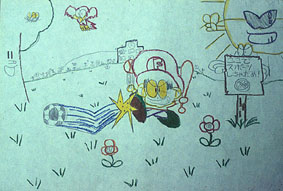
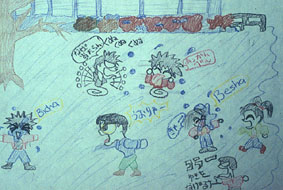
(Japanese 4th G. boy's drawing) (Japanese 6th G. boy's drawing)
In response to this pop-cultural phenomenon, the
Ministry of Education in Japan decided to adapt the benefit of pop-culture
to the national art educational curricula for 8th and 9th grades in compulsory
education in1998. In a course of study of the national art educational
curriculum for secondary grades, which will be implemented in April, 2002,
the Ministry of Education proposes, "By adapting pop-culture (manga, illustration,
photo, video, computers), to express studentsí thoughts/ideas of what they
think and what they want to be" (Spring, 1998). In Japan, the Ministry
of Education has changed six times (1947, 1951, 1958, 1968, 1977, and 1989)
in theory and practice in the field of art education since World War II.
Through more than 50 years of educational history, this seventh reform
(2002) is the first art educational reform which considers childrenís preference/aesthetic
in the curriculum.
In responding to this proposal of the course of
study in art education, art educators have started to look for art educational
programs with mangaís techniques and contexts. For example, Izumiya (2000)
proposes a visual comprehension test as the first step of implementing
mangaís technique in secondary art education. The test involves drawing
something by memory in order to communicate a common subject or situation
to a second person. The purpose of this practice is to make students realize
that they tend not to pay attention to such common subjects and how drawing
simple subjects is not so easy. As the second step, Izumiya also recommends
drawing a common situation in ordinary life by using mangaís techniques
of composition such as close-ups and distant views in diverse alignments
of frames. Furthermore, before and after the Ministry of Education proposal,
many manga technique books were published. In spite of the fact that those
books are not offered for the educational purposes, they started to be
used as textbooks especially at the university level as great reference
books to learn to create attractive characters and stories.
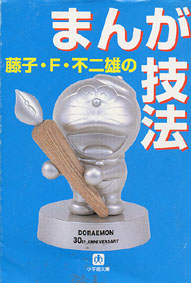
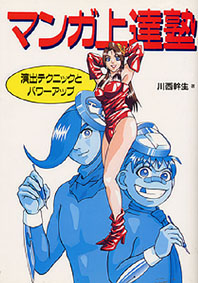
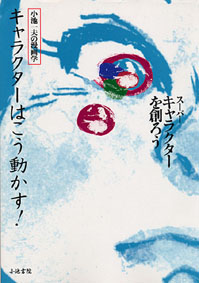
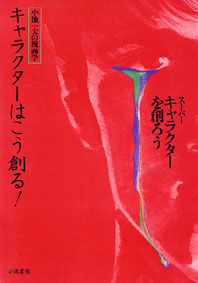
In the U.S., Hobbs and Salome (1995) encourage drawing
a four-panel cartoon based on a joke, event or story, using visual cues
and sequences of frames to suggest movement. They believe that the experience
takes advantage of studentsí interest in comics as a means of introducing
them to sequence and implied movement. Students can apply these concepts
to art criticism and aesthetic appreciation (pp. T120). Interestingly
and coincidentally, Wilson (1989) gave Japanese children (K-9th grades)
a visual test to create a sequential story in six frames. In his collections,
there is no doubt that the influences of manga appeared strongly regardless
of age differences. The children effectively use manga's techniques of
exaggeration and movement to create attractive stories in six frames. At
California State University, Chico, a professor of Japanese language, Nomura,
has his students draw a 4-frame comic to use the Japanese that they learn
in class.
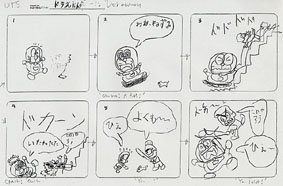
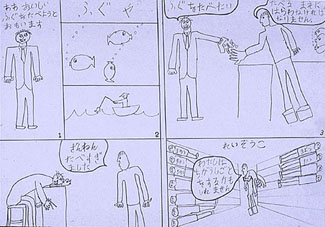
(Japanese 2nd G. Boy's drawing)
(College student's manga story drawing for Japanese class)
Conclusion
Likewise, the techniques of manga give art teachers an
opportunity to support the development of studentsí visual thinking skills
such as observation, articulation, and critical thinking skills. By drawing
a scene of ordinary life in sequential frames, students will pay attention
to life and nature around them. These manga activities make art more meaningful
to students and will give them a chance to find their identity by depicting
themselves in a narrative story.
The role of the art teacher is not to just teach either
the techniques of art making or the absolute value of art by making or
looking at art, but rather to encourage students to create art to find
themselves in their own ways. While thinking of what the artwork is through
the process of art making and critique of artworks, they will find how
art is meaningful for themselves in their lives. In other words, it is
important to make students realize that there are diverse ways to create
art to express themselves by including diverse values from different cultures.
This may be easier said than done, since teachers themselves
often have difficulty implementing the proper art program to encourage
students to make it meaningful for them. Especially in secondary education,
many teachers struggle to face the imbalance between studentsí physical
growth and mental growth. Their physical ability reaches almost the level
of adults, but their mentality is still in the process of developing. As
a result, we tend to bring our own values to art without thinking of studentsí
own preference and aesthetics for art. Itís time to open our eyes to look
at whatís going on in this world to know what is the most attractive artistic
theme for students, while not necessarily for us. If there is a pop-cultural
phenomenon, which starts to attract children, we should learn the advantages
and the disadvantages of the particular pop-culture to look at the possibility
of implementing it in art education.
The Japanese critic of pop-culture Natsume says, "when
we learn something, we need a motive power, which should be to like something,
to be interested in it, and for it to be fun" (1999, p.8)
For students who are in such a period of losing interest/motivation for art especially during secondary grades, we should find something to provide the motive power of learning and developing studentsí critical thinking skills. Manga has a wonderful communicative function. By using the mechanism of manga, it might be possible to find our own identity in the narrative art. Itís time to reevaluate pop-culture to give students motivation to create their own value and identity through making and criticizing art.
REFERENCES
Bruner, J. (1990). Acts of meaning. Cambridge,
MA: Harvard University Press.
Bruner, J. (1996). The culture of education. Cambridge,
MA: Harvard University Press.
Duncum P. (1986). Breaking down the alleged "U"
curve of artistic development. Visual Arts Research, 12 (1), 43 - 54.
Gardner H. (1990). Art Education and Human Development.
Santa Monica, CA: The Getty Center for Education in the Arts.
Hobbs J. & Salome R. (1995). The Visual Experience
(2nd. Ed.). Worcester, VA: Davis Publications.
Hardiman, G. W. & Zernich, T. (1988). Some considerations
of Piagetís cognitive - structuralist Theory and childrenís artistic development.
In Hardiman, G.W. & Zernich, T. (Eds.). Discerning art: concepts and
issues. (pp. 355 - 365). Champaign, IL: Stipes Publishing Company
Izumiya T. (2000). Bijyutsushitsu de no manga no tsukiaikata
[How to work with manga in art room]. In Art in Education. 61 (1). Tokyo:
The Society for Art in Education.
Lowenfeld, V. & Brittain, W.L. (1970). Creative
and mental growth. (5th ed.). New York: Macmillan.
Natsume, F. (1997). Manga no Bunpou [Grammar of
Manga]. In Comic gaku no mikata [How to look at Comic]. Asahi Shinbun Extra
Report & Analysis Special. 1997. 24, 86 ? 95. Tokyo: Asahi shinbun
Natsume, F (1997). Why manga is interesting?: expression
and grammar [Manga wa naze omoshiroi]. Tokyo: Nippon housou kyoukai.
Natsume, F. (1999). Manga ga suki [I like manga].
In Magazine for Art Education. 49 (8). 7-12. Tokyo: Biiku Bunka
Read, H. (1958). Education through art. New York:
Pantheon Book
Schilling, M. (1997). The Encyclopedia of Japanese
Pop Culture. New York: Weatherhill, Inc.
Schodt, F.L. (1983). The World of Japanese Comics.
New York: Kodansha America, Inc.
Toku, M. (2000). Cross-cultural Analysis of Artistic
Development: Drawings by Japanese and U.S. children. Paper accepted Visual
Arts Research, 26 (1).
Wilson, B. (1988). The artistic tower of babel:
in extricable links between culture and graphic development. In Hardman,
G.W. & Zernich, T. (Ed.), Discerning art: concepts and
issues. (pp. 488 - 506). Champaign, IL: Stipes Publishing Company.
Wilson, B. (1996). The influence of manga on Japanese
childrenís drawings: Art and the social construction of character. Unpublished
manuscript, the Pennsylvania State University.
Wilson, B. (1997). Empire of signs revisited: Childrenís
manga and the changing face of Japan. Paper presented at the symposium
of the Cultural Context: Comparative Studies of Art Education and Childrenís
Drawings, Vilnius, Lithuania.
Wilson, B (1999). Becoming Japanese: Manga, Childrenís
Drawings, and the Construction of National Character. In Visual Arts Research.
25 (2). (pp. 48-60).
Yang, J., Can, D., and Hong, T. (1997). Eastern Standard
Time: A guide to Asian influence on American culture from Astro boy to
Zen Buddhism. New York: Houghton Mifflin Company.
Yonezawa Y. (1994), Syojo manga no sekai [The World
of Girlís Manga]. Tokyo: Heibonsya.
Yonezawa Y. (1997). Syounen manga no sekai [The
World of Boyís Manga]. Tokyo: Heibonsya